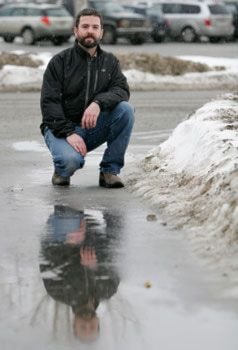Fierce arguments over the fate of polar bears in a warming world have as much to do with misunderstandings and hurt feelings as they do with the facts, says Doug Clark, Yukon College’s researcher in residence.
Not that there’s any agreement on many facts when you enter a room that has biologists on one side, who have painstakingly gathered data that demonstrates a polar bear subpopulation has declined over several decades, and on the other, Inuit hunters who have seen with their own eyes a growing number of bears maraud through their community and invade campsites.
Throw a dollop of political spin into the mix, for polar bears are an intensely political subject, seized upon by environmentalists and climate-change deniers alike to advance their causes, and whatever middle ground exists easily disappears.
Enter Clark, a scientist whose field of research has shifted from studying grizzly bears to studying the people who study polar bears.
In December, he and colleagues published a paper in the journal Nature that examines the social dynamics behind today’s controversies of polar bear management.
The politicization of polar bears has done much to damage the already strained trust between scientists and Inuit hunters, the paper concludes.
His solution sounds more like relationship counselling than hard-nosed science. He wants everybody to sit down and talk things through.
“It comes down to people stuff. It comes down to communication and trust and treating people with respect,” he said.
“Those are the kinds of things that come off those ‘what I need to learn in Kindergarten’ posters, but they’re important. You can never get away from it, especially in the North.”
He’ll put his ideas to the test later this month, when Whitehorse should be crawling with polar bear researchers. He’s invited two dozen scientists, field workers and members of wildlife management boards from Canada’s three territories, Ontario and Labrador to meet in Whitehorse from January 30 to February 1.
The meeting comes on the heels of a national polar bear roundtable that the federal government held last week in Winnipeg. That meeting helped nudge some groups towards reconciliation, and Jim Prentice, the Environment minister, seems to understand that “we need to do better,” said Clark.
“It was pretty amazing. I was impressed with what I saw come out of that,” said Clark.
The timing of Clark’s meeting shortly after the roundtable is unintentional, but it may prove to be ideal, he said.
Still, it’s hard to see how some high-minded goals of integrating science with Inuit traditional knowledge will succeed when the two viewpoints appear to outright contradict each other, as is the case in the state of polar bears in western Hudson Bay.
Scientists have linked the decline of polar bears there over several decades with shrinking sea ice, which bears depend upon as a platform to hunt seals. Yet Inuit hunters insist they have never seen so many bears before, so much so that it is no longer safe to go camping.
But even here, Clark sees primarily a communication break-down, rather than an outright contradiction.
“I think this is where scientists in published literature have fallen down,” he said. “They don’t explore what Inuit are really saying. There’s a whole lot of nuance and detail that gets missed.”
Just because there are more bear sightings doesn’t mean there are more bears. Bears could be gathering near communities because they have less food.
But such explanations usually don’t sit well with Inuit of the region, who insist there are lots of bears—scientists are just looking in the wrong places when they conduct surveys.
Again, what’s missing here is trust, said Clark.
Both sides are responsible, but it’s not an equal playing field.
“Scientists have the resources to do a better job than what’s been done. I think they do have a special responsibility.”
“It’s not a simple process. It’s not quick. And it’s not glamorous—it’s a whole lot of hard work over a long period of time, and a whole lot of getting people to work outside their comfort zone.”
It is estimated that 15,500 polar bears—about two-thirds of the world’s population—live in Canada in 13 distinct sub-populations, spread from Yukon’s north shore to the east coast of Baffin Island. Five of these sub-populations are believed to be in decline.
Contact John Thompson
at johnt@yukon-news.com.
